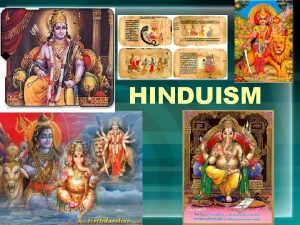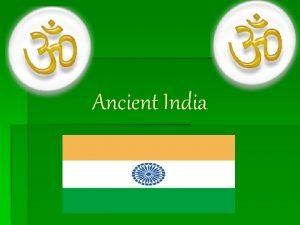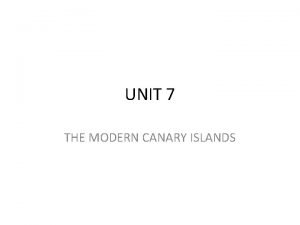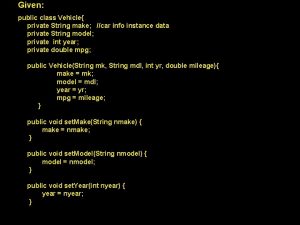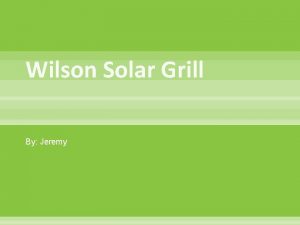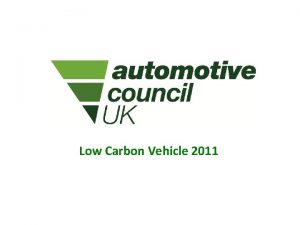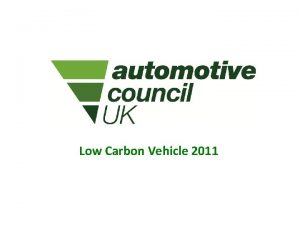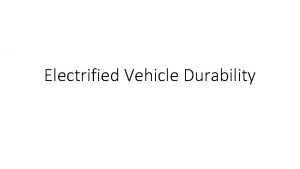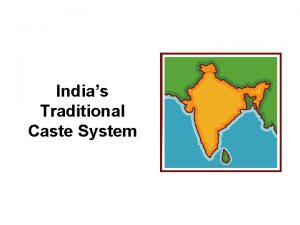Indias commentsSuggestions on Low Powered Vehicle Cycle designed















- Slides: 15

India’s comments/Suggestions on Low Powered Vehicle Cycle designed by Heinz Steven Z A Mujawar WLTP/DHC meeting on 29 th March 2012 at Ispra, Italy. 1

Low Powered Vehicle Cycle Proposal for Vehicle Classes by Heinz Steven Ø Class 1: pmr < [21] k. W/t, ü v_max < [70] km/h, low speed part with highly reduced accelerations, ü v_max >= [70] km/h, low and medium speed parts with highly reduced accelerations. Ø Class 2: [21] k. W/t <= pmr < [35] k. W/t, ü v_max < [90] km/h, low and medium speed parts with reduced accelerations, ü v_max >= [90] km/h, low, medium and high speed parts with reduced accelerations. Ø Class 3: pmr >= [35] k. W/t, ü v_max < [135] km/h, low, medium and high speed parts of WLTC V 4, ü v_max >= [135] km/h, all parts (L, M, H & Ex H of WLTC V 4) 2

India’s Concerns on Low Powered Vehicle Cycle § The Low Powered Vehicle Cycle Class 1 proposed by Mr. Heinz Steven needs to be modified for better driveability on chassis dynamometer and moderated in the deceleration portions to avoid excessively aggressive braking. § Modification 1 is shown in Slide No. 7 in which the Short Trip “A” is interchanged with Short Trip “B” marked in Slide No. 6. §Modification 1 in Slide No. 7 also show the idling portions interchanged at the later part of the Cycle. § Also the maximum speed of the last Short Trip needs to be reduced from 52 km/h to 45 km/h. This would allow the vehicles with max. speed of 55 to 60 km/h to go through the Cycle without opening full throttle. 3

India’s Concerns on Low Powered Vehicle Cycle §Modification 2 in Slide No. 8 shows the need for moderating the deceleration in the last Short Trip to avoid excessively aggressive braking. §For Class 2 Low, Middle and High phases the deceleration needs to be reduce to lower than WLTC Ver 4. See Slide No. 10, 11 and 12. § The drive cycle for Class 2 also needs to have gradual speed increase. This can be achieved by interchanging the first & the last short trips in low speed phase as shown in Slide No. 10. § Modification 3 Our earlier tests indicate that the vehicle does not get fully warmed up after middle speed phase. Hence, in order to get more realistic conditions, the third phase needs to be added for all class-1 & class-2 vehicles. This can be achieved by repeating the phases. Further inputs can be given after conducting LPVC 4 Validation 1.

Low Powered Vehicle Cycle Acceleration/Deceleration: Class 1_Low Phase • In C 1_L-Phase, the deceleration is greater than in WLTP V 4 cycle. These deceleration points are hard to follow on the dyno and need to be moderated to avoid excessively aggressive 5 braking.

Low Powered Vehicle Cycle The Short Trip “A” is interchanged with Short Trip “B” 6

Low Powered Vehicle Cycle Reduce the max speed from 52 km/h to 45 km/h. Interchanged the idling portion. Replace low speed driving portion at ~ 372 sec by idling. 7

Low Powered Vehicle Cycle This deceleration needs to be moderated. Moderate the deceleration in the last Short Trip reduce excessive braking. 8

Low Powered Vehicle Cycle 9

Low Powered Vehicle Cycle Interchange the short trips Reduce the max deceleration for LPVC to lower than WLTC Ver 4. The first & the last short trip needs to be interchanged. 10

Low Powered Vehicle Cycle This deceleration & acceleration needs to be moderated. A steady speed step also needs to be provided. 11

Low Powered Vehicle Cycle Reduce the max deceleration for LPVC Class 2 High phase. 12

WLPT Cycle WLTP Cycle for Different Class of Vehicles 11/03/12

India’s Concerns on Low Powered Vehicle Cycle § Further comments from India will be given after Steven Gear Shift for LPVC is studied and Validation test are conducted on Low Powered Vehicles. §WLTP group is requested to consider the modifications suggested on the low powered vehicle cycle before going to start validation due to availability of resources and time constraints. § For Low Powered Vehicles the GTR test mass should not be increased from that of current reference mass. 14

Thank You 15
 Indias religions
Indias religions Indias religions
Indias religions Indias major religion
Indias major religion Indias first empire
Indias first empire Indias first civilization
Indias first civilization Flota de indias ruta
Flota de indias ruta How many castes are there in india
How many castes are there in india Sociedad colonial americana
Sociedad colonial americana Indias first empire
Indias first empire Private string
Private string Middle = low + (high - low) / 2
Middle = low + (high - low) / 2 Reflective communication style
Reflective communication style High precision vs high accuracy
High precision vs high accuracy Low voltage = low hazard
Low voltage = low hazard Wilson solar grill
Wilson solar grill Sap business one analytics
Sap business one analytics


